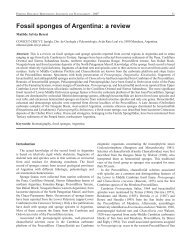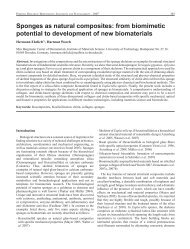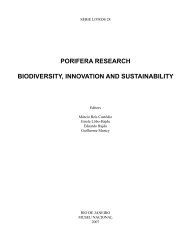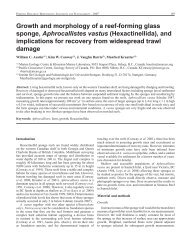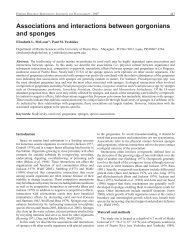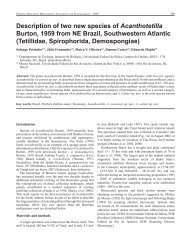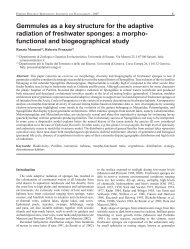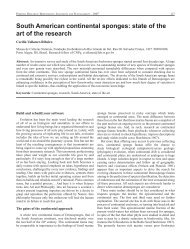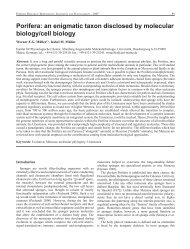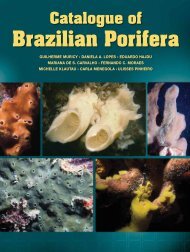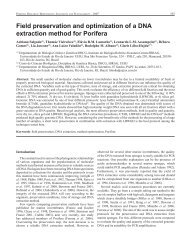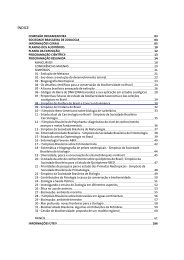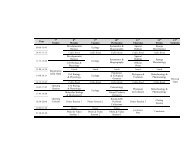Reading the code of coral reef sponge community ... - Porifera Brasil
Reading the code of coral reef sponge community ... - Porifera Brasil
Reading the code of coral reef sponge community ... - Porifera Brasil
Create successful ePaper yourself
Turn your PDF publications into a flip-book with our unique Google optimized e-Paper software.
<strong>Porifera</strong> Research: Biodiversity, Innovation and Sustainability - 2007<br />
<br />
<strong>Reading</strong> <strong>the</strong> <strong>code</strong> <strong>of</strong> <strong>coral</strong> <strong>reef</strong> <strong>sponge</strong> <strong>community</strong><br />
composition and structure for environmental biomonitoring:<br />
some experiences from Cuba<br />
Pedro M. Alcolado<br />
Instituto de Oceanología, Ave. 1ra, No. 18406, Playa, La Habana, Cuba. alcolado@ama.cu<br />
Abstract: The structure <strong>of</strong> exposed (non-cryptic) <strong>coral</strong> <strong>reef</strong> <strong>sponge</strong> communities could be considered as a potentially readable<br />
<strong>code</strong>d message reflecting <strong>the</strong>ir physical environment. The present paper describes explorations in Cuba <strong>of</strong> <strong>the</strong> potential use <strong>of</strong><br />
<strong>sponge</strong> communities as bio-indicators. Clathria venosa is <strong>the</strong> <strong>sponge</strong> that most consistently has proved to be a bioindicator <strong>of</strong><br />
urban based pollution in Cuban <strong>coral</strong> <strong>reef</strong>s due to its stenotopic character with regard to this stress source. Iotrochota birotulata<br />
forma musciformis was abundant close to <strong>the</strong> polluted Havana Bay, but not in o<strong>the</strong>r polluted sites, making it inconsistent as<br />
indicator. It has been quite rare in non-polluted waters. Cliona delitrix was represented in an area with great sewage influence.<br />
However it did not appear in some polluted sites probably because <strong>coral</strong>s were extremely scarce and small. Scopalina ruetzleri<br />
was well represented close to bays with different degrees <strong>of</strong> urban based pollution. Cliona varians was well represented only<br />
in one polluted place. Multivariate analyses (cluster analysis, non-metric multidimensional scaled analysis) have proved to be<br />
very useful tools to clearly segregate sites with regard to level <strong>of</strong> pollution, and to identify factors and interactions determining<br />
<strong>community</strong> structure and composition. Abundance or dominance <strong>of</strong> Tectitethya crypta and Cliona vesparia (alpha stage) were<br />
typical <strong>of</strong> heavy sedimentation conditions; while Aplysina cauliformis tended to dominate in sites affected by both hurricanes<br />
and sedimentation (abundance increased by fragmentation). Meta-analysis <strong>of</strong> Shannon’s heterogeneity index H’ and Pielou’s<br />
equitability index J’ is proposed as a useful tool to classify and compare sites with regard to <strong>the</strong> way that <strong>sponge</strong>s interpret<br />
<strong>the</strong>ir environment (degree <strong>of</strong> severity and predictability). Meta-analysis by means <strong>of</strong> a scatter graph with ranges <strong>of</strong> H’ at<br />
different depths provides a spatial framework for comparing and classifying <strong>sponge</strong> communities with regard to environment<br />
severity.<br />
Keywords: <strong>sponge</strong>s, bio-indicators, <strong>coral</strong> <strong>reef</strong>s, Cuba<br />
Introduction<br />
Many papers have dealt with <strong>the</strong> factors and interactions that<br />
determine <strong>sponge</strong> distribution and <strong>community</strong> characteristics<br />
(partly reviewed by Sarà and Vacelet 1973, Bergquist<br />
1978, Wulff 2006), but few have been explicitly devoted to<br />
exploring <strong>the</strong> potential usefulness <strong>of</strong> <strong>sponge</strong> communities as<br />
bio-indicators for environmental bio-monitoring purposes.<br />
In <strong>the</strong> last few decades, <strong>the</strong> search for bio-indicators<br />
has become an urgent need in a world environment that is<br />
changing at an unprecedented rate. According to Alcolado<br />
(1984; with some added arguments), sessile taxa are suitable<br />
as potential environmental bio-indicators because:<br />
- They must be adapted to <strong>the</strong> environment due to <strong>the</strong>ir<br />
immobility. Thus, <strong>the</strong>ir abundance or <strong>the</strong>ir presence (or even<br />
absence) must reflect <strong>the</strong> average ecological conditions, or<br />
very recent strong stressful events.<br />
- Their composition and <strong>community</strong> structure are not affected<br />
by migrations or local displacements.<br />
- The exposed (non-cryptic) <strong>sponge</strong> communities, having<br />
passed <strong>the</strong> fish predation filter thanks to deterrence (Wulff<br />
1997), are influenced more by <strong>the</strong> physical environment<br />
than by ecological interactions within <strong>the</strong>mselves (sensu<br />
Bradbury 1977). Cooperation ra<strong>the</strong>r than competition<br />
seems to be <strong>the</strong> rule among <strong>sponge</strong> populations (Sarà 1970)<br />
and, according to Rützler (1970), <strong>sponge</strong>s are able to solve<br />
competition by entering into complex epizoic relationships,<br />
without detriment to <strong>the</strong>ir pumping and filtering activities.<br />
Reiswig (1973) adds that small <strong>sponge</strong> individuals (during<br />
<strong>the</strong> first year after settlement) are subject to severe mortality<br />
by competition with o<strong>the</strong>r sessile organisms, but when<br />
<strong>sponge</strong>s reach greater volume competitors have little fur<strong>the</strong>r<br />
effect. On <strong>the</strong> o<strong>the</strong>r hand, <strong>sponge</strong>s overgrow <strong>coral</strong>s much<br />
more frequently than <strong>the</strong> reverse, although when <strong>the</strong> reverse<br />
occurs, <strong>the</strong> <strong>sponge</strong> tissue shows no adverse effect (Jackson<br />
and Buss 1975).<br />
- The absence <strong>of</strong> food partitioning mechanisms influencing<br />
<strong>community</strong> structure.<br />
Such features favor <strong>sponge</strong>s over many o<strong>the</strong>r zoological<br />
groups as potential indicators. That does not mean that<br />
<strong>the</strong>re could not be some degree <strong>of</strong> influence <strong>of</strong> biological<br />
interactions, but apparently to a much lower extent than <strong>the</strong><br />
physical environment (light, waves, sediments, pollution) in<br />
building up <strong>the</strong> <strong>community</strong> structure and composition. This
also makes <strong>community</strong> structure and composition easier to<br />
analyze and to understand in a bio-monitoring context.<br />
For <strong>the</strong>se reasons, <strong>the</strong> structure <strong>of</strong> exposed (non-cryptic)<br />
<strong>coral</strong> <strong>reef</strong> <strong>sponge</strong> communities could be considered as a<br />
potentially readable <strong>code</strong>d message reflecting how <strong>sponge</strong>s<br />
interpret <strong>the</strong>ir physical environment. Indeed, <strong>sponge</strong>s have<br />
been suggested as potential environmental bio-indicators by<br />
Alcolado (1984, 1985, 1990, 1992, 1994, 1999), Alcolado and<br />
Herrera (1987), Muricy (1989, 1991), Zea (1994), Alcolado et<br />
al. (1994), Carballo et al. (1994, 1996), Carballo and Naranjo<br />
(2001), and Vilanova et al. (2004). Some attempts and<br />
successes in Cuba and o<strong>the</strong>r countries exploring <strong>the</strong> potential<br />
use <strong>of</strong> <strong>sponge</strong> communities as simpler, faster and lower cost<br />
bio-indicators (from a <strong>sponge</strong> life perspective) are discussed<br />
below. The results compiled in this review come from a great<br />
number <strong>of</strong> <strong>coral</strong> <strong>reef</strong> sites sampled around Cuba since 1976.<br />
Discussion<br />
Indicator species<br />
A few <strong>sponge</strong> species have been found to be associated<br />
with polluted or relatively unpolluted conditions in <strong>coral</strong> <strong>reef</strong>s<br />
(Table 1). Particularly, Clathria venosa (Alcolado, 1984)<br />
and Iotrochota birotulata forma musciformis (Duchassaing<br />
and Michelotti, 1864) have only been observed dominating<br />
in fore-<strong>reef</strong>s (10-20 m deep) affected by organic pollution<br />
(Alcolado and Herrera 1987) (Table 1; Fig. 1). The first<br />
species appeared to be markedly stenotopic <strong>of</strong> enriched<br />
inshore and <strong>coral</strong> <strong>reef</strong> waters and its occurrence has been<br />
very consistent in all polluted <strong>reef</strong>s evaluated or visited in<br />
northwestern Cuba (close to Havana Bay, Almendares and<br />
Quibú rivers, and <strong>the</strong> town <strong>of</strong> Santa Fé), and according to<br />
Zea (1994), also in Santa Marta, Colombia. This species<br />
was previously reported by Hechtel (1965) on shells and<br />
piling in <strong>the</strong> enriched waters <strong>of</strong> Port Royal (sou<strong>the</strong>rn shore<br />
<strong>of</strong> Kingston Harbor), Jamaica (as Microciona microchela<br />
n. sp.); and by van Soest (1984) in <strong>the</strong> fouling <strong>community</strong><br />
on dead <strong>coral</strong>s and gorgonians at <strong>the</strong> bay and Hilton Hotel<br />
Landing <strong>of</strong> Curaçao (as Rhaphidophlus raraechelae n. sp.).<br />
It was also found in <strong>the</strong> fouling communities <strong>of</strong> <strong>the</strong> concrete<br />
dock <strong>of</strong> Marina Barlovento (organically enriched site) and<br />
<strong>the</strong> seawall <strong>of</strong> a small organically polluted cove (Rada del<br />
Instituto de Oceanología), both in <strong>the</strong> western Havana City,<br />
Cuba. However, I. birotulata forma musciformis was not<br />
consistently dominant or abundant in <strong>the</strong> visited Cuban<br />
polluted sites.<br />
Mycale microsigmatosa Arndt, 1927, which has been<br />
found dominating under domestic sewage stress in Brazil<br />
(Muricy 1989), was also found in a very polluted coastal<br />
lagoon at Jaimanitas Town, west <strong>of</strong> Havana city (muddy/<br />
algal bottom) toge<strong>the</strong>r with well developed Suberites<br />
aurantiaca (Duchassaing and Michelotti, 1964), Chondrilla<br />
aff. nucula Schmidt, 1862 and Halichondria melanadocia de<br />
Laubenfels, 1936. Both S. aurantiaca and C. aff. nucula are<br />
“bacterio<strong>sponge</strong>s” (Rützler 2002), which could explain <strong>the</strong>ir<br />
abundance in this lagoon.<br />
Holmes (1997, 2000), Holmes et al. (2000) and Rützler<br />
(2002), comment on <strong>the</strong> increased abundance and activity <strong>of</strong><br />
boring <strong>sponge</strong>s in areas affected by urban based pollution.<br />
Indeed, Cliona delitrix Pang, 1973, a species reported as<br />
abundant in areas submitted to sewage pollution (Rose and<br />
Risk 1985, Chávez-Fonnegra and Zea 2006), was observed<br />
during four years by Marcos and Alcolado (unpublished<br />
observations) with significant relative abundance (%) at a<br />
fore-<strong>reef</strong> site close to both <strong>the</strong> polluted Quibú River and a<br />
nearby sewage outfall (western Havana City). However, it<br />
was not found by Alcolado and Herrera (1987) at stations<br />
near Havana Bay, maybe due to <strong>the</strong> scarcity and small size <strong>of</strong><br />
<strong>coral</strong>s (dominated by Siderastrea radians Pallas, 1766).<br />
Ano<strong>the</strong>r boring <strong>sponge</strong>, Cliona varians (Duchassaing and<br />
Michelotti, 1864), was well represented only in a polluted<br />
fore-<strong>reef</strong> close to both <strong>the</strong> Quibú River and a nearby sewage<br />
outfall at western Havana City (Marcos and Alcolado<br />
unpublished observations). However, it was also common<br />
Table 1: Potential indicator species and <strong>the</strong>ir respective inferred condition according to authors. D and M = Duchassaing and Michelotti.<br />
Dominant or abundant species Indicated condition Author<br />
Clathria venosa (Alcolado, 1984) Organic pollution Alcolado and Herrera (1987)<br />
Iotrochota birotulata f. musciformis (D. and M., 1864) Organic pollution Alcolado and Herrera (1987)<br />
Scopalina ruetzleri (Wiedenmayer, 1977) Moderate organic pollution Alcolado and Herrera (1987);<br />
Muricy (1989); Zea (1994)<br />
Sewage pollution Muricy (1989)<br />
Cliona delitrix Pang, 1973 Sewage (bacterial) pollution Rose and Risk (1985)<br />
Mycale microsigmatosa Arndt, 1927 Sewage pollution Muricy (1989)<br />
Amphimedon viridis D. and M., 1864 Sewage pollution Muricy (1989)<br />
Aplysina fistularis (Pallas, 1766) Comparatively non-polluted Alcolado (present paper, Fig. 1)<br />
Cliona caribbaea D. and M., 1864 Comparatively non-polluted López-Victoria and Zea (2004)<br />
Cliona vesparia (Lamarck, 1815) (alpha stage) Sedimentation plus wave stress Alcolado (present paper)<br />
Tectitethya crypta (de Laubenfels, 1949) Sedimentation stress Alcolado and Gotera (1985)<br />
Aplysina fulva (Pallas, 1766) Strong waves Wulff (1995)<br />
Aplysina cauliformis (Carter, 1882) Eventual strong waves and sedimentation Alcolado (present paper)
Fig. 1: Relative abundances <strong>of</strong><br />
potential pollution bioindicators<br />
species, presented as percentages<br />
<strong>of</strong> total <strong>sponge</strong> abundance (number<br />
<strong>of</strong> individuals), at stations located<br />
at different distances from two<br />
main pollution sources in <strong>the</strong><br />
north-western Cuba (Havana Bay<br />
and Almendares River). Mariel<br />
Bay is not significantly polluted.<br />
in non-polluted <strong>reef</strong> areas, which makes it inconsistent as a<br />
potential bio-indicator.<br />
López-Victoria and Zea (2004) showed that <strong>the</strong> abundance<br />
<strong>of</strong> Cliona caribbaea is not related to pollution in San Andrés<br />
Archipelago, Colombia. Indeed, this species did not occur at<br />
sites close to <strong>the</strong> organically polluted Quibú River and <strong>the</strong><br />
nearby sewage outfall, but only in more distant sites (Marcos<br />
and Alcolado, unpublished observations).<br />
O<strong>the</strong>r <strong>sponge</strong> species have been associated with factors<br />
o<strong>the</strong>r than pollution, namely sedimentation and wave stress<br />
(Table 1). Particularly, Aplysina cauliformis is apparently<br />
tolerant to strong waves, as can be deduced from its dominance<br />
in <strong>coral</strong> <strong>reef</strong> sites exposed to more frequent tropical storms<br />
(keys Juan García and Cantiles, southwestern Cuba). This can<br />
be due to its branching morphology, flexibility and elasticity,<br />
similar to what was suggested by Wulff (1995) for Aplysina<br />
fulva, also branching and with ra<strong>the</strong>r similar consistency.<br />
The suggested usefulness <strong>of</strong> <strong>the</strong> presence or abundance<br />
<strong>of</strong> some <strong>sponge</strong>s as environmental indicators has been<br />
based much on expert observation and on inferences<br />
related to distance from known pollution sources, wave<br />
and wind exposure, visual evidence <strong>of</strong> varying intensity <strong>of</strong><br />
sedimentation, etc. For that reason, to validate <strong>the</strong>se results<br />
and make fur<strong>the</strong>r progress, more evidence is necessary,<br />
obtained both from well designed experiments and from<br />
multivariate analysis in which factors are directly measured<br />
on appropriate temporal and spatial scales. Additionally,<br />
more sites in <strong>the</strong> Wider Caribbean, suffering various degrees<br />
<strong>of</strong> pollution, tropical storm frequency, exposure to waves and<br />
dominant winds, etc., are worth being researched to test <strong>the</strong><br />
generality <strong>of</strong> <strong>the</strong> mentioned findings. It would be <strong>of</strong> particular<br />
interest to determine if Clathria venosa feeds on bacteria with<br />
emphasis on enteric taxa, as does Clathria prolifera (Ellis and<br />
Solander, 1786) according to Claus et al. (1967).<br />
Community indices<br />
In agreement with o<strong>the</strong>r authors (Muricy 1989, Carballo et<br />
al. 1996, among o<strong>the</strong>rs), Alcolado and Herrera (1987) found<br />
that species richness and Shannon´s heterogeneity index H’<br />
were lower at more polluted sites (Fig. 2). Pielou’s equitability<br />
index J’ was also lower in <strong>the</strong> more polluted sites close to <strong>the</strong><br />
mouth <strong>of</strong> Almendares River (Fig. 2).<br />
Given that a condition <strong>of</strong> significant stress can be inferred<br />
only when <strong>the</strong> dominance <strong>of</strong> some <strong>of</strong> <strong>the</strong> mentioned indicator<br />
species (Table 1) is coupled with low values <strong>of</strong> species<br />
richness or species heterogeneity (Alcolado et al. 1994),<br />
<strong>the</strong>se univariate indices have to be taken into account as an<br />
important complement for environmental monitoring.<br />
The summing up <strong>of</strong> <strong>the</strong> numerical percentages <strong>of</strong><br />
individuals belonging to species that are tolerant to <strong>the</strong> same<br />
kind <strong>of</strong> stressor (e.g., pollution, sedimentation, turbulence,<br />
etc.) could be useful as ano<strong>the</strong>r potential <strong>community</strong> index<br />
for monitoring purposes, as done by Alcolado (1981) with<br />
gorgonians to infer relative turbulence intensity, and by<br />
Herrera-Moreno (1991), also with gorgonians, to infer relative<br />
organic pollution level.<br />
The usefulness and conceptual validity <strong>of</strong> diversity indices<br />
has been controversial (Hurlbert 1971, Peet 1974). However<br />
(without disregarding potential pitfalls), <strong>the</strong> herein explored<br />
diversity indices can be used and tested pragmatically and<br />
heuristically for bio-monitoring purposes in <strong>the</strong> context <strong>of</strong><br />
environmental management, not specifically for advancing
Fig. 2: H’ and J’ in stations located<br />
at different distances from two<br />
main pollution sources in <strong>the</strong><br />
north-western Cuba (Havana Bay<br />
and Almendares River). Mariel<br />
Bay is not significantly polluted.<br />
science (but being increasingly supported by scientific<br />
research). The same validation and progress efforts can be<br />
applied to <strong>community</strong> indices.<br />
Environmental severity and predictability inference<br />
graph<br />
Preston and Preston (1975) deserve <strong>the</strong> credit for<br />
integrating and applying <strong>the</strong>oretical criteria from classic<br />
<strong>community</strong> ecology in a simple and practical scheme to infer<br />
<strong>the</strong> environmental severity and predictability (constancy) for<br />
comparative purposes. According to Margalef (1963, 1968)<br />
and Odum (1969), high species diversity and high equitability<br />
are generally associated with mature, late successional<br />
stages. On <strong>the</strong> o<strong>the</strong>r hand, Sanders (1969) and Slobodkin<br />
and Sanders (1969) hypo<strong>the</strong>size that severe environments<br />
generally permit less diversity to develop than favorable<br />
ones do. As suggested by Slobodkin and Sanders (1969)<br />
and supported by Preston and Preston (1975), <strong>the</strong> degree<br />
<strong>of</strong> stress is determined primarily by <strong>the</strong> degree <strong>of</strong> temporal<br />
predictability <strong>of</strong> environmental conditions and <strong>the</strong> degree <strong>of</strong><br />
physiological stress imposed by <strong>the</strong> physical environment.<br />
After Preston and Preston (1975), by means <strong>of</strong> <strong>the</strong> values<br />
<strong>of</strong> H’ and J’ three different ecological situations can be<br />
inferred: high values <strong>of</strong> both indices suggest a favorable<br />
and predictable environment; a low H’ coupled to a high J’<br />
indicates a constantly severe environment; and low values <strong>of</strong><br />
both indices reflect an unpredictably severe environment.<br />
Due to <strong>the</strong> fact that this scheme excessively reduces <strong>the</strong><br />
real variety <strong>of</strong> situations and leads to misinterpretation <strong>of</strong><br />
<strong>the</strong> specific case <strong>of</strong> extremely low values <strong>of</strong> both indices, it<br />
was modified by Alcolado (1992) for <strong>sponge</strong>s (Fig. 3). This<br />
modification consisted <strong>of</strong> an inference diagram obtained from<br />
a scatter graph <strong>of</strong> pairs <strong>of</strong> H’ and J’ values from 112 sites.<br />
The resulting scatter area was divided into 11 “environmental<br />
inference zones or classes” reflecting corresponding<br />
ecological situations instead <strong>of</strong> Preston and Preston’s (1975)<br />
original three zones or classes (constantly favorable, constant<br />
or temporally predictable stress and unpredictable stress).<br />
Except for <strong>the</strong> class 1 <strong>of</strong> <strong>the</strong> scale, which is a qualitative<br />
addition to <strong>the</strong> original scheme, <strong>the</strong> remaining classes resulted<br />
from subdividing <strong>the</strong> original overly inclusive classes. This<br />
resulted in a finer grain <strong>of</strong> environmental situations to infer,<br />
matching more closely <strong>the</strong> relatively wide range <strong>of</strong> withinclass<br />
environmental variability perceived in <strong>the</strong> field by <strong>the</strong><br />
author within <strong>the</strong> original three classes (e.g., <strong>sponge</strong> size, <strong>coral</strong><br />
size and cover, wind and wave exposure, etc.). The number<br />
<strong>of</strong> subdivisions preferred among different persons would<br />
certainly vary, as happens with <strong>the</strong> different temperature<br />
measurement scales (Celsius, Fahrenheit and Kelvin). The<br />
new scale comprises <strong>the</strong> following environmental severitypredictability<br />
classes: 1 = environment extremely stressed by<br />
both, a constant basal level <strong>of</strong> disturbance and intermittent<br />
unpredictable strong events (H’ = 0-1.3 natural bells; J’ = 0-<br />
0.5); 2 = very severe and unpredictable environment (H’ =<br />
0-1.3 natural bells; J’ = 0.5-0.69); 3 = severe and unpredictable<br />
environment (H’ = 1.3-2.0 natural bells; J’ = 0.5-0.69);<br />
4 = almost constantly severe environment (H’ = 1.3-2.0<br />
natural bells; J’ = 0.7-0.8); 5 = constantly severe environment
(e.g., Cliona aprica, among <strong>sponge</strong>s, Gorgonia flabellum<br />
Linnaeus, 1758, among gorgonians, and Acropora palmata<br />
Lamarck, 1816, among scleractinians). For that reason, both<br />
J’ an H’ show extremely low values. This combination, within<br />
Preston and Preston’s (1976) original scheme, would suggest<br />
an unpredictable environment (with its constant component<br />
omitted).<br />
Alcolado’s (1992) inference diagram also differentiates<br />
<strong>the</strong> very favorable and constant environments <strong>of</strong> <strong>the</strong> deep<br />
<strong>reef</strong>s (e.g., at 20-30 m) within <strong>the</strong> rank 11, from those that are<br />
simply favorable and quasi-constant (rank 10). Never<strong>the</strong>less,<br />
it is advisable to be aware <strong>of</strong> specific situations <strong>of</strong> very longterm<br />
environmental stability where some species can escape<br />
from demographic control and become excessively dominant,<br />
and consequently diminishing H’ and J’. This situation is<br />
common at <strong>reef</strong> sites deeper than 25 m. This phenomenon <strong>of</strong><br />
<strong>community</strong> senescence is not contemplated in ei<strong>the</strong>r <strong>of</strong> <strong>the</strong><br />
two mentioned inference methods and has to be taken into<br />
account in supposedly extremely constant environments (e.g.,<br />
deep <strong>reef</strong> zones, and <strong>reef</strong>s where hurricanes are very rare, as<br />
those <strong>of</strong> Bonaire and Tobago).<br />
The author’s scale is proposed as an alternative reference<br />
(among o<strong>the</strong>r possible ones) and could be tested and improved<br />
with fur<strong>the</strong>r research. More sites across <strong>the</strong> Wider Caribbean<br />
should be studied and included in <strong>the</strong> scatter graph to refine<br />
its spatial contour.<br />
<br />
Fig. 3: Inference diagram reflecting eleven ways in which <strong>sponge</strong>s<br />
interpret <strong>the</strong>ir physical environment, derived from a meta-analysis<br />
with 112 <strong>coral</strong> <strong>reef</strong> stations. 1 = extremely severe with mixture<br />
<strong>of</strong> constant and unpredictable environment; 2 = very severe<br />
and unpredictable; 3 = severe and unpredictable; 4 = quasiconstantly<br />
severe; 5 = constantly severe; 6 = moderately severe<br />
and unpredictable; 7 = moderately severe and quasi-constant; 8 =<br />
moderately severe and constant; 9 = favorable and quasi-constant;<br />
10 = constantly favorable; and 11 = very favorable and constant.<br />
(H’ = 1.3-2.0 natural bells; J’ = 0.8-1); 6 = moderately and<br />
unpredictably severe environment (H’ = 2.0-2.5 natural bells;<br />
J’ = 0.5-0.69); 7 = moderately and almost constantly severe<br />
environment (H’ = 2.0-2.5 natural bells; J’ = 0.7-0.8); 8 =<br />
moderately and constantly severe environment (H’ = 2.0-2.5<br />
natural bells; J’ = 0.8-1); 9 = favorable and almost constant<br />
environment (H’ = 2.5-2.9 natural bells; J’ = 0.7-0.8); 10 =<br />
favorable and constant environment (H’ = 2.5-2.9 natural<br />
bells; J’ = 0.8-1); and 11 = very favorable and constant<br />
environment (H’ >2.9 natural bells; J’ = 0.8-1).<br />
Rank 1 shows a (qualitative) situation that is not<br />
considered by Preston and Preston (1975). This is <strong>the</strong> case<br />
<strong>of</strong> <strong>the</strong> surf zones <strong>of</strong> some Cuban <strong>reef</strong>s, which have constant<br />
average (basal or chronic) conditions <strong>of</strong> fairly strong wave<br />
action, but which are also unpredictably affected by severe<br />
impacts <strong>of</strong> tropical storms. Under <strong>the</strong>se circumstances, <strong>the</strong>re<br />
is only one predominant species within each sessile taxon<br />
Scatter graphs for comparing <strong>community</strong> indices at<br />
different depths<br />
Scatter graphs <strong>of</strong> variability <strong>of</strong> <strong>sponge</strong> diversity indices,<br />
population density and cover with regard to depth were<br />
obtained for many Cuban <strong>reef</strong> sites (Alcolado 1994, 1999).<br />
These graphs, which display <strong>the</strong> area (range) <strong>of</strong> variation <strong>of</strong><br />
those indices with regard to depth, can be used as a reference<br />
pattern to infer in a comparative way <strong>the</strong> <strong>community</strong> condition<br />
within stress gradients, taking into account site depth, given<br />
that such indices do not necessarily behave in <strong>the</strong> same way<br />
along depth gradients. What is normally a moderate value <strong>of</strong><br />
H’ for a given depth could be considered a high value for a<br />
lower depth.<br />
The upper border <strong>of</strong> <strong>the</strong> variation area (an ascending convex<br />
line with a slight diminution at depths greater than 25 m)<br />
reflects <strong>the</strong> best conditions registered at different depths for<br />
<strong>sponge</strong> species richness and species heterogeneity (Fig. 4),<br />
while <strong>the</strong> lower border (an asymptotically ascending curve)<br />
shows <strong>the</strong> worst environmental conditions at different depths<br />
(Alcolado 1994).<br />
Care must be taken at deep <strong>reef</strong> stations (about 30 m depth<br />
or more), as lower diversities can be caused by extremely<br />
constant and favorable conditions that lead to <strong>the</strong> dominance<br />
<strong>of</strong> competitively stronger species, and not by any stressor. The<br />
same recommendations given for <strong>the</strong> environmental severity<br />
and predictability inference graph are applicable here.<br />
Classification and ordination<br />
Classification (Fig. 5) and ordination (Fig. 6) analyses<br />
have proved to be useful when using <strong>sponge</strong> communities<br />
to separate sites with regard to degree <strong>of</strong> pollution and
Fig. 4: Example <strong>of</strong> meta-analysis as a scatter graph <strong>of</strong> H’ values at<br />
different depths, with classification bands <strong>of</strong> inferred environmental<br />
conditions (from 112 <strong>coral</strong> <strong>reef</strong> sites <strong>of</strong> Cuba). Care must be taken<br />
at stations about 30 m depth or more, as lower diversities can be<br />
determined by extremely constant and favorable conditions leading<br />
to dominance <strong>of</strong> very competitive species, and not by severe<br />
environmental conditions. Arrows indicate more polluted stations<br />
(10 m depth) and stations affected by sediments (deeper stations).<br />
Fig. 6: MDS analysis segregating stations located at different<br />
distances from two main pollution sources (Havana Bay and<br />
Almendares River) with regard to degree <strong>of</strong> pollution (from left to<br />
right: very polluted, polluted, and little polluted). This analysis was<br />
done with quadratic transformation <strong>of</strong> <strong>sponge</strong> densities and Bray<br />
Curtis similarity Index.<br />
Fig. 5: Cluster analysis segregating stations located at different<br />
distances from two main pollution sources (Havana Bay and<br />
Almendares River) with regard to degree <strong>of</strong> pollution (going<br />
downwards: very polluted, polluted, and little polluted). This analysis<br />
was done with quadratic transformation <strong>of</strong> <strong>sponge</strong> densities, Bray<br />
Curtis similarity Index, and un-weighted paired average clustering.<br />
to explore <strong>the</strong> factors impinging on <strong>the</strong>ir structure and<br />
composition (Alcolado and Herrera 1987, Muricy 1989,<br />
1991, Carballo et al. 1994, 1996, Carballo and Naranjo<br />
2001, Bell and Barnes 2003, Vilanova et al. 2004, Marcos<br />
and Alcolado unpublished observations). Particularly, <strong>the</strong><br />
Multidimensional Scaled analysis (MDS) has provided<br />
clear results (PRIMER version 5). Multivariate techniques<br />
are useful tools for identifying factors and interactions, and<br />
as such have to be applied complementarily with simpler,<br />
faster and lower cost univariate inference approaches in<br />
environmental monitoring. Multivariate analyses have to<br />
serve also to streng<strong>the</strong>n <strong>the</strong> validation and to reduce <strong>the</strong> pitfalls<br />
<strong>of</strong> potential indicator species and ecological indices that have<br />
been proposed, to a great extent based on observational and<br />
inference approaches.<br />
In <strong>the</strong> context <strong>of</strong> <strong>the</strong> application <strong>of</strong> <strong>the</strong> suggested biomonitoring<br />
methods, an aspect that deserves future effort is<br />
to assess <strong>the</strong> convenience <strong>of</strong> using <strong>sponge</strong> cover instead <strong>of</strong><br />
<strong>sponge</strong> density, both from practical and scientific points <strong>of</strong><br />
view.<br />
Finally, ano<strong>the</strong>r matter <strong>of</strong> concern could be <strong>the</strong> need<br />
<strong>of</strong> <strong>sponge</strong> taxonomy skills for <strong>the</strong> implementation <strong>of</strong> <strong>the</strong><br />
proposed bio-monitoring methods. In this sense, <strong>the</strong> potential<br />
indicator species are easy to identify in situ, and sampling<br />
for calculation <strong>of</strong> <strong>community</strong> indices would only require<br />
differentiation <strong>of</strong> species, and not necessarily identification to<br />
species level. With some practice, <strong>the</strong> identification <strong>of</strong> most<br />
common species can be learned and <strong>the</strong> sampling work can<br />
become even easier.<br />
Acknowledgements<br />
I would like to thank <strong>the</strong> National Museum <strong>of</strong> Rio de<br />
Janeiro, PETROBRAS, <strong>the</strong> UNDP/GEF Project Sabana-<br />
Camagüey and Dr. Robert N. Ginsburg (Ocean Research and<br />
Education Foundation) for making possible my participation<br />
in <strong>the</strong> 7 th International Sponge Symposium. I am grateful to<br />
Dr. Janie Wulff, Dr. Georgina Bustamante and Marta Rivero<br />
for <strong>the</strong>ir valuable comments to <strong>the</strong> manuscript.<br />
References<br />
Alcolado PM (1981) Zonación de los gorgonáceos someros de<br />
Cuba y su posible uso como indicadores comparativos de tensión
hidrodinámica sobre los organismos del bentos. Inf Cient-Téc Inst<br />
Oceanol Acad Cien Cuba 187: 1-43.<br />
Alcolado PM (1984) Utilidad de algunos índices ecológicos<br />
estructurales en el estudio de comunidades marinas de Cuba. Cien<br />
Biol 11: 61-77<br />
Alcolado PM (1985) Estructura ecológica de las comunidades de<br />
esponjas de Punta del Este, Cuba. Rep Invest Inst Oceanol Acad<br />
Cien Cuba 38: 1-65<br />
Alcolado PM (1990) General features <strong>of</strong> Cuban <strong>sponge</strong> communities.<br />
In: Rützler K (ed). New perspectives in <strong>sponge</strong> biology. Smithsonian<br />
Institution Press, Washington DC. pp. 351-357<br />
Alcolado PM (1992) Sobre la interpretación del medio marino<br />
mediante el empleo de los índices de diversidad y equitatividad.<br />
Cien Biol 24: 124-127<br />
Alcolado PM (1994) General trends in <strong>coral</strong> <strong>reef</strong> <strong>sponge</strong> communities<br />
<strong>of</strong> Cuba. In: van Soest RWM, van Kempen TMG, Braekman JC<br />
(eds). Sponges in time and space: biology, chemistry, paleontology.<br />
Balkema, Rotterdam. pp. 251-255<br />
Alcolado PM (1999) Comunidades de esponjas de los arrecifes del<br />
Archipiélago Sabana-Camagüey, Cuba. Bol Invest Mar Cost 28:<br />
95-124<br />
Alcolado PM, Gotera GG (1985) Estructura de las comunidades<br />
de esponjas en arrecifes cubanos. Contrib Simp Cien Mar, VII<br />
Jornada Cient Inst Oceanol, XX Aniv 1: 11-15<br />
Alcolado PM, Herrera A (1987) Efectos de la contaminación sobre<br />
las comunidades de esponjas en el Litoral de La Habana, Cuba.<br />
Rep Invest Inst Oceanol Acad Cien Cuba 68: 1-17<br />
Alcolado PM, Herrera-Moreno A, Martínez-Estalella N (1994)<br />
Sessile communities as environmental bio-monitors in Cuban<br />
<strong>coral</strong> <strong>reef</strong>s. In: Ginsburg RN (ed). Proceeding <strong>of</strong> <strong>the</strong> Colloquium<br />
on “Global aspects <strong>of</strong> <strong>coral</strong> <strong>reef</strong>s: health hazards and history,<br />
1993” RSMAS, University <strong>of</strong> Miami. pp. 27-33<br />
Bell JJ, Barnes DK (2003) Effect <strong>of</strong> disturbance on assemblages: an<br />
example using <strong>Porifera</strong>. Biol Bull 3(1): 144-159<br />
Bergquist PR (1978) Sponges. Hutchinson & Co., London<br />
Bradbury RH (1977) Independent lies and holistic truths: towards a<br />
<strong>the</strong>ory <strong>of</strong> <strong>coral</strong> <strong>reef</strong>s communities as complex systems. Proc 3 rd Int<br />
Coral Reef Symp, Miami 1: 2-17<br />
Carballo JL, Sánchez-Moyano JE, García-Gómez JC (1994)<br />
Taxonomic and ecological remarks on boring <strong>sponge</strong>s (Clionidae)<br />
from <strong>the</strong> Strait <strong>of</strong> Gibraltar (sou<strong>the</strong>rn Spain): tentative bioindicators<br />
Zool J Linnean Soc 112: 407-424<br />
Carballo JL, Naranjo SA, García-Gómez JC (1996) Use <strong>of</strong> marine<br />
<strong>sponge</strong>s as stress indicators in marine ecosystems at Algeciras Bay<br />
(sou<strong>the</strong>rn Iberian Peninsula). Mar Ecol Progr Ser 135: 109-122<br />
Carballo JL, Naranjo S (2001) Environmental assessment <strong>of</strong> a large<br />
industrial marine complex based on a <strong>community</strong> <strong>of</strong> benthic filter<br />
feeders. Mar Poll Bull 44: 605-610<br />
Claus G, Madri P, Kunen S (1967) Removal <strong>of</strong> microbial pollutants<br />
from waste effluents by <strong>the</strong> redbeard <strong>sponge</strong>. Nature 216: 712-<br />
714<br />
Chávez-Fonnegra A, Zea S (2006) Observation <strong>of</strong> <strong>reef</strong> <strong>coral</strong><br />
undermining by <strong>the</strong> Caribbean excavating <strong>sponge</strong> Cliona delitrix<br />
(Demospongiae, Hadromerida). In: Custódio MR, Lôbo-Hajdu G,<br />
Hajdu E, Muricy G (eds). 7 th International Sponge Symposium -<br />
Book <strong>of</strong> Abstracts (Armação dos Búzios, Brazil). Museu Nacional,<br />
Série Livros, vol. 16. p. 324<br />
Hechtel G (1965) A systematic study <strong>of</strong> <strong>the</strong> Demospongiae <strong>of</strong> Port<br />
Royal, Jamaica. Bull Peabody Mus nat Hist 20: 1-94<br />
Herrera-Moreno A (1991) Efectos de la contaminación sobre<br />
la estructura ecológica de los arrecifes <strong>coral</strong>inos en el litoral<br />
Habanero. PhD Thesis. Instituto de Oceanología, La Habana<br />
Holmes KE (1997) Eutrophication and its effect on bioeroding<br />
<strong>sponge</strong> communities. Proc 8 th Int Coral Reef Symp, Balboa 2:<br />
1411-1416<br />
Holmes KE (2000) Effects <strong>of</strong> eutrophication on bioeroding <strong>sponge</strong><br />
communities, with description <strong>of</strong> new West Indian <strong>sponge</strong>s Cliona<br />
spp. (<strong>Porifera</strong>, Hadromerida: Clionaidae). Invert Biol 119: 125-<br />
138<br />
Holmes KE, Edinger EN, Hariyadi, Limmon GV, Risk MJ (2000)<br />
Bioerosion <strong>of</strong> Live Massive Corals and Branching Coral Rubble<br />
on Indonesian Coral Reefs. Mar Poll Bull 40(7): 606-617<br />
Hurlbert SH (1971) The nonconcept <strong>of</strong> species diversity: A critique<br />
and alternative parameters. Ecology 52: 577-586<br />
Jackson JBC, Buss L (1975) Allelopathy and spatial competition<br />
among <strong>coral</strong> <strong>reef</strong> invertebrates. Proc Natl Acad Sci USA 72: 5160-<br />
5163<br />
López-Victoria M, Zea S (2004) Current trends <strong>of</strong> space occupation<br />
by encrusting excavating <strong>sponge</strong>s on Colombian <strong>coral</strong> <strong>reef</strong>s. Mar<br />
Ecol 26: 33-41<br />
Margalef R (1963) On certain unifying principles in ecology. Am<br />
Nat 97: 357-374<br />
Margalef R (1968) Perspectives in ecological <strong>the</strong>ory. University <strong>of</strong><br />
Chicago Press, Chicago<br />
Muricy G (1989) Sponges as pollution bio-monitors at Arraial do<br />
Cabo, Sou<strong>the</strong>astern Brazil. Rev Bras Biol 49(2): 347-354<br />
Muricy G (1991) Structure des peuplements de spongiaires autour<br />
de l’égout de Cortiou (Marseille, France). Vie et Milieu 41(4): 205-<br />
221<br />
Odum EP (1969) The strategy ecosystem development. Sciences<br />
164: 262-270<br />
Peet RK (1974) The measurement <strong>of</strong> species diversity. Ann Rev Ecol<br />
Syst 5: 285-307<br />
Preston EM, Preston JL (1975) Ecological structure in a West Indian<br />
gorgonian fauna. Bull Mar Sci 252: 248-258<br />
Reiswig HM (1973) Population dynamics <strong>of</strong> three Jamaican<br />
Demospongiae. Bull Mar Sci 23: 191-226<br />
Rose CS, Risk MG (1985) Increase in Cliona delitrix infestation <strong>of</strong><br />
Montastraea cavernosa heads on an organically polluted portion<br />
<strong>of</strong> <strong>the</strong> Grand Cayman fringing <strong>reef</strong>. Mar Ecol 6(4): 345-363<br />
Rützler K (1970) Spatial competition among <strong>Porifera</strong>: solution by<br />
epizoism. Oecologia 5: 85-95<br />
Rützler K (2002) Impact <strong>of</strong> crustose clionid <strong>sponge</strong>s on Caribbean<br />
<strong>reef</strong> <strong>coral</strong>s. Acta Geo Hisp 37(1): 61-72<br />
Sanders HL (1969) Benthic marine diversity and <strong>the</strong> stability-time<br />
hypo<strong>the</strong>sis. Brookhaven Symp Biol 22: 71-81<br />
Sarà M (1970) Competition and cooperation in <strong>sponge</strong> populations.<br />
Symp Zool Soc Lond 25: 273-284<br />
Sarà M, Vacelet J (1973) Écologie des Demo<strong>sponge</strong>s. In: Grassé PP<br />
(ed). Traité de Zoologie, Vol. 3, Masson et Cie, Paris. pp. 462-576<br />
Slobodkin LB, Sanders HL (1969) On <strong>the</strong> distribution <strong>of</strong><br />
environmental predictability to species diversity. Brookhaven<br />
Symp Biol 22: 82-93<br />
van Soest RWM (1984) Marine <strong>sponge</strong>s from Curacao and o<strong>the</strong>r<br />
Caribbean localities. Part. III. Poecilosclerida. Stud Fauna Curacao<br />
Caribb Isl 66(199): 1-167<br />
Vilanova E, Mayer-Pinto M, Curbelo-Fernandez MP, Gonçalves da<br />
Silva SH (2004) The impact <strong>of</strong> a nuclear power plant discharge on<br />
<strong>the</strong> <strong>sponge</strong> <strong>community</strong> <strong>of</strong> a tropical bay (SE Brazil). In: Pansini M,
10<br />
Pronzato R, Bavestrello G, Manconi R (eds). Sponge science in <strong>the</strong><br />
new millennium. Boll Mus Ist Biol Univ Genova 68: 647-644<br />
Wulff JL (1995) Hurricane effects on survival and orientation <strong>of</strong><br />
large erect <strong>coral</strong> <strong>reef</strong> <strong>sponge</strong>s. Coral Reefs 14: 55-61<br />
Wulff JL (1997) Parrotfish predation on cryptic <strong>sponge</strong>s <strong>of</strong> Caribbean<br />
<strong>coral</strong> <strong>reef</strong>s. Mar Biol 129(1): 41-52<br />
Wulff JL (2006) Ecological interactions <strong>of</strong> marine <strong>sponge</strong>s. Can J<br />
Zool 84(2): 146-166<br />
Zea S (1994) Patterns <strong>of</strong> <strong>coral</strong> and <strong>sponge</strong> abundance in degraded<br />
versus still healthy <strong>coral</strong> <strong>reef</strong>s at Santa Marta Colombian<br />
Caribbean. In: van Soest RWM, van Kempen TMG, Braekman JC<br />
(eds). Sponges in time and space: biology, chemistry, paleontology.<br />
Balkema, Rotterdam. pp. 257-264



